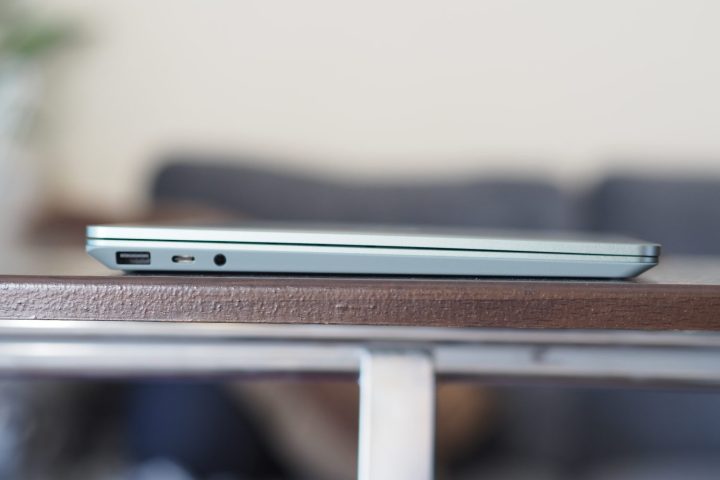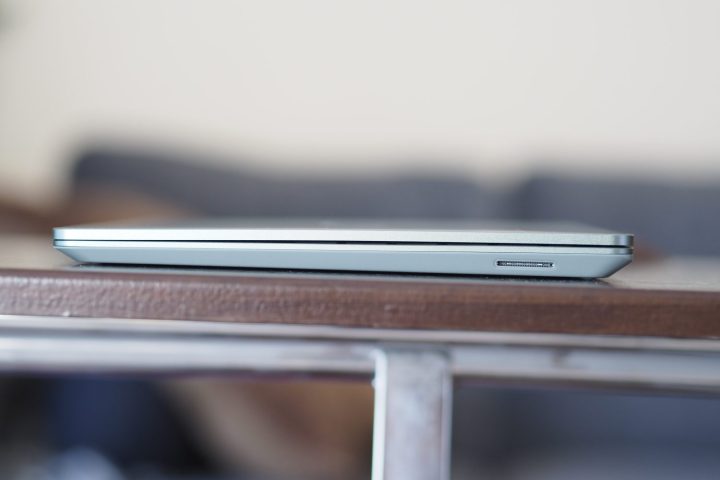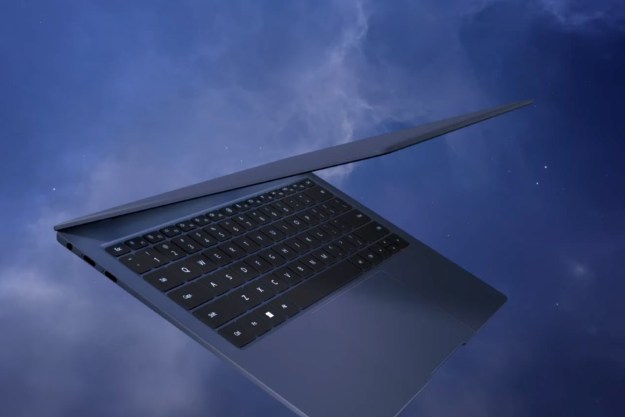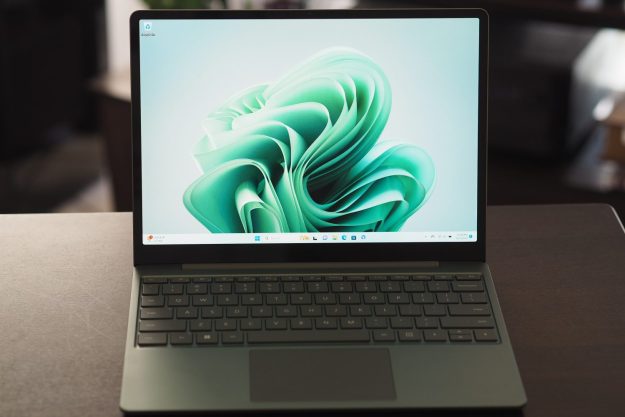
“Microsoft's new, more expensive Surface Laptop Go 3 doesn't have the perks to justify its jacked-up price.”
- Attractive aesthetic
- Small and light chassis
- Great audio
- Too expensive
- Cramped and stiff keyboard with no backlighting
- Low-resolution display
- Wi-Fi and webcam are behind the curve
- Disappointing battery life
Microsoft’s traditional entry into the very competitive budget laptop market is the Surface Laptop Go, which we reviewed in 2020 when it was first introduced. The laptop is now in its third generation, and while the form factor has remained largely unchanged, the internal components have been upgraded. But the price has also gone up considerably, inching the Surface Laptop Go 3 out of the budget category and into the midrange.
Now starting at $800, up from $600 for the Surface Laptop Go 2, the Surface Laptop Go 3 faces a lot of competition. The Asus ZenBook 14 OLED is one example of a machine to beat in this class, and as we’ll see, Microsoft’s contender doesn’t always stack up favorably. The Surface Laptop Go 3 needs to offer something special to compete, and frankly, I didn’t find anything that stands out.
Specs and configurations
| Microsoft Surface Laptop Go 3 | |
| Dimensions | 10.95 inches x 8.12 inches x 0.0.62 inches |
| Weight | 2.49 pounds |
| Processor | Intel Core i5-1235U |
| Graphics | Intel Iris Xe |
| RAM | 8GB 16GB |
| Display | 12.4-inch 3:2 PixelSense 1,536 x 1,024 IPS display |
| Storage | 256GB SSD |
| Touch | Yes |
| Ports | 1 x USB-C 3.2 1 x USB-A 3.1 1 x 3.5mm audio jack 1 x Surface Connect port |
| Wireless | Wi-Fi 6 and Bluetooth 5.1 |
| Webcam | 720p |
| Operating system | Windows 11 |
| Battery | 41 watt-hours |
| Price |
$800+ |
Microsoft offers two configurations of the Surface Laptop Go 3. The base model has an Intel Core i5-1235U CPU, 8GB of RAM, a 256GB SSD, and a 12.4-inch IPS display. Upgrade to 16GB of
There’s a lot of better competition for this much money, including the
A design that begs for a lower price

At a time when manufacturers are going larger with their laptops, particularly introducing more 14-inch machines, Microsoft has maintained the Surface Laptop Go 3’s diminutive stature. It’s built around a 12.4-inch display, with reasonably small display bezels around the top and sides. That makes it very small in width and depth, which forces at least one compromise you’ll notice when you go to type. We’ll get more into that below.
It’s not extraordinarily thin at 0.62 inches and it still manages to weigh 2.49 pounds. That’s light, but you expect that from such a small laptop. In comparison, the Dell XPS 13 9315 has a 13.4-inch display and is all aluminum, but weighs just 2.59 pounds. The
The Surface Laptop Go 3 sports an aluminum lid and keyboard deck, while the bottom chassis is plastic – something that’s no longer common in midrange
Aesthetically, the Surface Laptop Go 3 is an attractive laptop, with sleek lines and the usual Surface elegance. It can be had in one of four colors: Platinum, Ice Blue, Sage, and Sandstone. Its look is a strength compared to many other
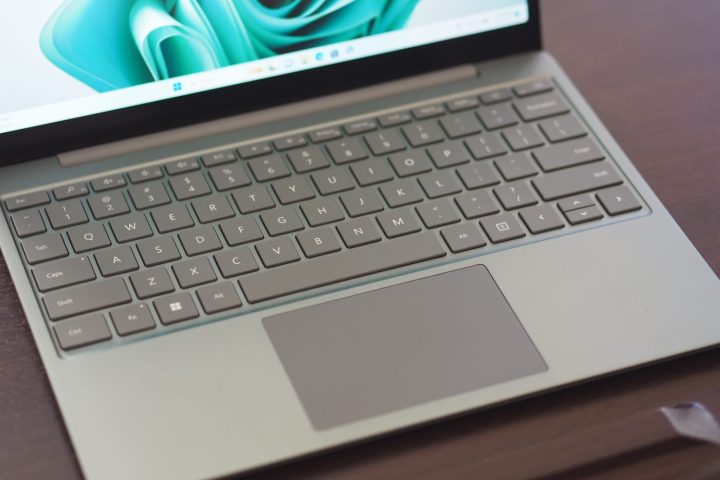
Normally, Surface devices have excellent keyboards, ranking up there with the best. That’s not the case with the Surface Laptop Go 3. To begin with, the narrow chassis forces a cramped keyboard, with decently sized keycaps but not enough spacing. It took me a while to get used to the keyboard’s dimensions, with my fingers often searching for the home row. The switches weren’t the greatest either, with sufficient travel but a surprisingly stiff feel and abrupt bottoming action. Perhaps most egregious was the lack of keyboard backlighting, an omission usually reserved for the cheapest budget
Connectivity is also limited, with a single USB-C port without Thunderbolt 4 support (something you’ll often find at these prices) and a single USB-A port. Power is provided by the Surface Connect port, which at least leaves the USB-C port available for use. Wireless connectivity is a step behind, with Wi-Fi 6 instead of the newer Wi-Fi 6E and Bluetooth 5.1.
Finally, the webcam is a disappointing 720p. That significantly impacts image quality compared to the 1080p and better webcams more commonly found on competing
Performance is also wanting

The Surface Laptop Go 3 uses a last-gen Intel CPU, the Core i5-1235U. This 15-watt medium-power CPU has 10 cores (two Performance and eight Efficient) and 12 threads, promising decent productivity performance. This is not the processing power you expect at $800.
Unfortunately, the Surface Laptop Go 3’s performance suffered. It was decidedly slower than almost all the other
I ran the Surface in both Recommended and Best Performance modes via the Windows 11 power slider, and while performance mode made for an improvement in some benchmarks, it caused a slowdown in others. That’s likely due to thermal throttling, and in any case, the performance mode wasn’t enough to lift the Surface Laptop Go 3 into contention.
The laptop will handle mainstream productivity tasks like web browsing, email, simple Office tasks, and the like. But it won’t handle anything demanding, particularly when it comes to extensive multitasking and using multiple cores. Certainly, tasks like gaming and video editing are out of the question.
| Geekbench 5 (single / multi) |
Handbrake (seconds) |
Cinebench R23 (single / multi) |
PCMark 10 Complete |
|
| Microsoft Surface Laptop Go 3 (Core i5-1235U) |
Bal: 1,179 / 5,652 Perf: 1,524 / 6,226 |
Bal: 194 Perf: 214 |
Bal: 1,118 / 5,170 Perf: 1,534 / 4894 |
4,227 |
| Asus Zenbook 14 OLED (Ryzen 5 7530U) |
Bal: 1,457 / 7,527 Perf: 1,458 / 8,207 |
Bal: 123 Perf: 121 |
Bal: 1,457 / 7,527 Perf: 1,458 / 8,207 |
5,817 |
| Dell XPS 13 9315 (Core i5-1230U) |
Bal: 1,393 / 4,459 Perf: 1,477 / 5,350 |
Bal: 333 Perf: 192 |
Bal: 1,379 / 3,457 Perf: N/A |
4,023 |
| Lenovo Flex 5i 14 2023 (Core i5-1335U) |
Bal: 1,671 / 7,935 Perf: 1,679 / 8,268 |
Bal: 181 Perf: 133 |
Bal: 1,634 / 6,918 Perf: 1,724 / 7,890 |
5,513 |
| Asus Zenbook S 13 OLED 2023 (Core i7-1355U) |
Bal: 1,829 / 6,893 Perf: 1,836 / 6,908 |
Bal: 157 Perf: 135 |
Bal: 1,629 / 6,005 Perf: 1,827 / 6,962 |
5,423 |
| Apple MacBook Air M1 (M1) |
Bal: 1.727 / 7,585 Perf: N/A |
Bal: 156 Perf: N/A |
Bal: 1,479 / 6,680 Perf: N/A |
N/A |
Disappointing battery life

The Surface Laptop Go 3 has 41 watt-hours of battery capacity, which should be more than enough for a laptop with a small, low-resolution display and a 15-watt CPU. Microsoft advertises 15 hours of battery life under “normal usage,” but I wasn’t able to get anywhere close to that.
In our web-browsing test, the Surface lasted for just 6.5 hours, well below most other
| Web browsing | Video | |
| Microsoft Surface Laptop Go 3 (Core i5-1235U) |
6 hours, 29 minutes | 13 hours, 35 minutes |
| Asus Zenbook 14 OLED (Ryzen 5 7530U) |
12 hours, 13 minutes | 17 hours, 19 minutes |
| Dell XPS 13 9315 (Core i5-1230U) |
13 hours, 8 minutes | N/A |
| Lenovo Flex 5i 14 2023 (Core i5-1335U) |
6 hours, 29 minutes | 11 hours, 43 minutes |
| Asus Zenbook S 13 OLED 2023 (Core i7-1355U) |
9 hours, 47 minutes | 15 hours, 14 minutes |
| Apple MacBook Air M1 (M1) |
15 hours, 31 minutes | 18 hours, 28 minutes |
A decent display, if not for the low resolution

The Surface Laptop Go 3 has a 12.4-inch PixelSense IPS display in the very tall 3:2 aspect ratio and with a very low 1,536 x 1,024 resolution. That makes it less than 1080p, which will cause video to run at a low resolution and cramp other horizontal content. It’s also not terribly sharp at just 149 pixels per inch (PPI), and it pales compared to the 2.8K OLED display in the
According to my colorimeter, the Surface Laptop Go 3’s display provides plenty of brightness, average color width, and a good contrast ratio. Its colors weren’t very accurate, though. The Dell XPS 13 9315’s display was brighter, offered higher contrast, and had a similar color width with much better accuracy. The
Overall, the Surface Laptop Go 3 has a display that’s good enough for typical productivity work in all but one important measurement. It’s held back by its low resolution, which is most noticeable when looking at pixelated text and 720p video.
| Brightness (nits) |
Contrast | sRGB gamut | AdobeRGB gamut | Accuracy DeltaE (lower is better) |
|
| Microsoft Laptop Go 3 (IPS) |
354 | 1,060:1 | 96% | 71% | 3.41 |
| Asus Zenbook 14 OLED (OLED) |
369 | 25,660:1 | 100% | 96% | 1.44 |
| Dell XPS 13 9315 (IPS) |
444 | 1,390:1 | 96% | 75% | 1.33 |
| Lenovo Flex 5i 14 2023 (IPS) |
329 | 1,330:1 | 63% | 48% | 3.11 |
| Apple MacBook Air M1 (IPS) |
389 | 1,130:1 | 100% | 79% | 1.39 |
Audio is provided by OmniSonic speakers that are located in the keyboard deck and pump sound out directly toward the user. I found the sound to be plenty loud, with crisp mids and highs and even a touch of bass. You can use the speakers for streaming media and listening to music, making audio a strength.
Conclusion
The Surface Laptop Go 3 suffers greatly from its price increase. As I’ve stressed throughout this review, you can get other
That leaves the Surface Laptop Go 3 in a difficult position. At its base price of $800, you can buy the
Editors' Recommendations
- The best budget laptops for 2023
- Surface Laptop Go 3 vs. Surface Pro 7+: is it an upgrade?
- Microsoft’s Surface Laptop Go 3 is a more capable budget laptop
- Microsoft’s Surface Laptop Studio 2 might get a massive performance boost
- The best fanless laptops in 2023
